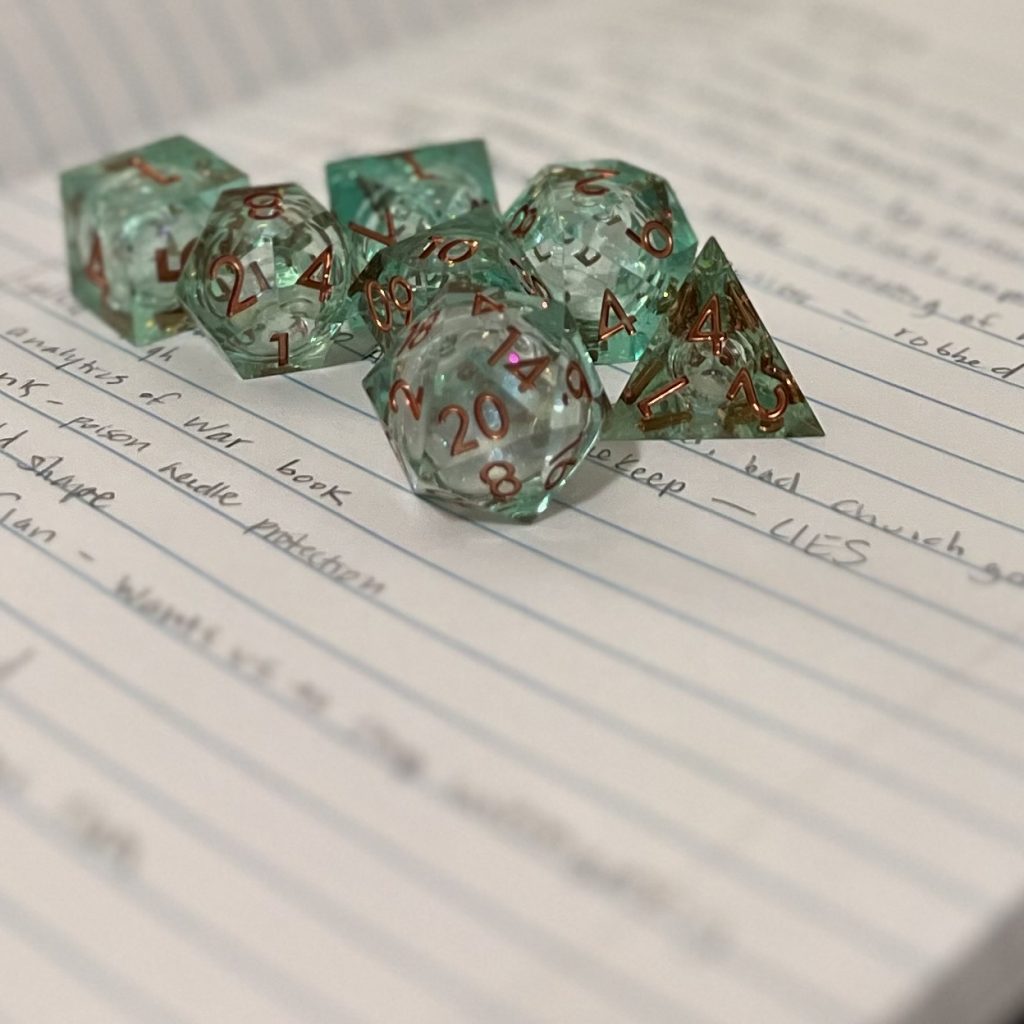

By: Katelin Schaub
Dungeons & Dragons (D&D) is a tabletop role-playing game that was released commercially in 1974.[2] The game operates with player characters created and piloted by members of the group and a Dungeon Master who acts as the author, narrator, and judge of potential disputes. [3] All the characters make their way through the game by creating a story using dice to determine their successes and failures. [4] D&D became much more popular during the pandemic, with sales jumping by 33%, leading to more curiosity about how the game’s intellectual property is protected. [5] The game itself is part of the intellectual property of the Wizards of the Coast, who protect intellectual property through trademarks.[6]
A trademark can be a work, design, symbol, or combination identifying a specific good or service. [7] Trademarks help customers connect the product or service to its source instead of any competitors. [8] For example, Wizards of the Coast currently owns a trademark in “DUNGEONS & DRAGONS” for “Entertainment services, namely, the provision of movies and ongoing television shows featuring fantasy stories and fantasy characters delivered by television, satellite, portable electronic devices or the internet; organizing and conducting game tournaments and entertainment exhibitions in the field of fantasy role-playing games; production and distribution of movies.” [9] Wizards of the Coast does not own the phrase “Dungeons & Dragons.” [10] They have the rights to “Dungeons & Dragons” being used with the stated goods or services.[11] Wizards of the Coast has registered 451 different trademarks, including the word “chainmail” as it pertains to fantasy role-playing war games.[12]
Wizards of the Coast also uses copyright protection. Copyright extends to an original work of authorship fixed in a tangible medium of expression.[13] The idea for a game of D&D, including the basic mechanics and rules of the game, cannot be copyrighted.[14] Instead, the written descriptions or plot lines, artwork associated with the manual, or even an especially distinct character could have access to copyright protection.[15] So, no one is allowed to copy or prepare derivatives of this material.[16]
It may be possible to get a patent for the mechanics of a game. The qualification requirements for a patent are that the invention must be new and useful and either a process, machine, manufacture, or composition of matter. [17]The invention must also be novel and non-obvious. [18] Wizards of the Coast has even patented an on-trading card game method of play for one of the other intellectual properties.[19] However, for D&D, the Wizards of the Coast have chosen two options for people to use their content: the open gaming license (OGL) with the System Reference Documents (SRDs) and Creative Commons.
Wizards of the Coast allows the use of their content in System Reference Documents (SRDs) through either the current original gaming license (OGL 1.0a) or through Creative Commons.[20] The open gaming license is an open content license that allows people to use the information contained in the SRD as long as they comply with the OGL 1.0a.[21] While Wizards of the Coast still hold their trademarks and protects the brand in this fashion, they have made these rules available to the D&D community. [22] The OGL 1.0a has some requirements for the use of their content, including that any open game content they distribute must contain a copy of the OGL 1.0a. [23] Creative Commons allows creators to use any content in the SRDs as long as they include an attribution statement. [24] Wizards of the Coast states that they chose to have Creative Commons as there are fewer restrictions than the OGL, and creators can be sure that Wizards of the Coast “can never revoke or deauthorize SRD 5.1 content.” [25] Both of these options allow users to design content or create their own stories and worlds using the rules and mechanics of D&D Fifth Edition.[26] With trademarks, copyrights, the OGL, and Creative Commons, Wizards of the Coast has fostered a vibrant community where players can become creators and continue to grow and improve the many worlds of D&D while still managing to protect and monetize their brand.
Citations:
[1] Cate Puglia, Photograph of TheWizardsVault Treasure of Atlantis dice set and Personal Notebook, https://www.etsy.com/listing/1206345346/treasure-of-atlantis-dice-set-liquid?click_key=29ebb85f1ebeaac430164caa8f6fc91e96550de3%3A1206345346&click_sum=3827c229&ref=shop_home_active_7&pro=1&sts=1
[2] Giuseppe Roberto Tarantino, If You Love Something, Set it Free? Open Content Copyright Licensing and Creative Cultural Expression (Nov. 22, 2019) (Ph.D. dissertation, Osgoode Hall Law School of York University), https://digitalcommons.osgoode.yorku.ca/cgi/viewcontent.cgi?article=1058&context=phd.
[3] Id.
[4] Id.
[5] Sarah Whitten, Dungeons & Dragons had its biggest year ever as Covid forced the game off tables and onto the web, CNBC, (Mar. 13, 2021, 9:08 AM), Dungeons & Dragons had its biggest year despite the coronavirus (cnbc.com)
[6] Tarantino, supra note 2.
[7] What is a Trademark?, USPTO, https://www.uspto.gov/trademarks/basics/what-trademark (Jul. 18, 2023, 9:10 AM).
[8] Id.
[9] DUNGEONS & DRAGONS, Registration No. 86,757,217.
[10] What is a Trademark?, Supra note 8.
[11] Id.
[12] CHAINMAIL, Registration No. 75,289,174.
[13] 17 U.S.C. § 102 (a).
[14] Id.
[15] U.S. COPYRIGHT OFF., COMPENDIUM OF U.S. COPYRIGHT OFF. PRACTICES § 714 (3d ed. 2021).; DC Comics v. Towle, 802 F.3d 1012 (9th Cir. 2015).
[16] 17 U.S.C. §§ 106 (1)-(2).
[17] 35 U.S.C. § 101.
[18] 35 U.S.C § 102.; 35 U.S.C. § 103.
[19] U.S. Patent No. 5,662,332 (filed Oct. 17, 1995).
[20] Systems Reference Document (SRD), Dnd.Wizards, https://dnd.wizards.com/resources/systems-reference-document
[21] Tarantino, supra note 2.
[22] Id.
[23] V5.1 Systems Reference Document (including the OGL), Dnd.Wizards, https://media.wizards.com/2016/downloads/DND/SRD-OGL_V5.1.pdf
[24] V5.1 Systems Reference Document (including the Creative Commons), Dnd.Wizards, https://media.wizards.com/2023/downloads/dnd/SRD_CC_v5.1.pdf
[25] Id.
[26] Id.
